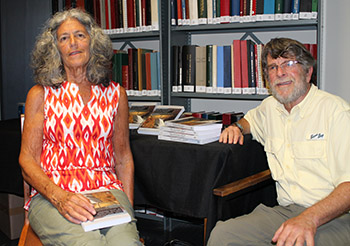
Prof Barbara Isaacman and Prof Allen Isaacman
Photo: Renè-Jean van der Berg |
When the plane crashed in Mbuzini, the entire country was submerged in a profound grieving.
This is how Prof Allen Isaacman, Regents Professor of History at the University of Minnesota, described the effect President Samora Machel’s death in 1986 had on Mozambique. In a public lecture, Prof Isaacman spoke about the man, Samora Machel, and the influences that shaped Machel’s life. The event, recently hosted by the UFS International Studies Group on the Bloemfontein Campus, was part of the Stanley Trapido Seminar Programme.
Samora Machel: from peasant to president
Born in 1933 into a peasant family, Machel was allowed to advance only to the third grade in school. “And yet,” Prof Isaacman said, “he became a very prominent local peasant intellectual and ultimately one of the most significant critics of Portuguese colonialism and colonial capitalism.” Machel had a great sense of human agency and firmly believed that one is not a mere victim of circumstances. “You were born into a world, but you can change it,” Prof Isaacman explained Machel’s conviction.
From herding cattle in Chokwe, to working as male nurse, Machel went on to become the leader of the Liberation Front of Mozambique (Frelimo) and ultimately the president of his country. To this day, not only does he “capture the imagination of the Mozambican people and South Africans, but is considered one the great leaders of that moment in African history,” Prof Isaacman concluded his lecture.
Displacement, and the Delusion of Development: Cahora Bassa and Its Legacies in Mozambique, 1965–2007
Later in the day, Profs Allen and Barbara Isaacman discussed their book: ‘Displacement, and the Delusion of Development: Cahora Bassa and Its Legacies in Mozambique, 1965–2007’ at the Archives for Contemporary Affairs. As authors of the book, they investigate the history and legacies of one of Africa's largest dams, Cahora Bassa, which was built in Mozambique by the Portuguese in the late 1960s and early 1970s.
The dam was constructed under conditions of war and inaugurated after independence by a government led by Frelimo. The dam has since operated continuously, although, for many years, much of its electricity was not exported or used because armed rebels had destroyed many high voltage power line pillars. Since the end of the armed conflict in 1992, power lines have been rebuilt, and Cahora Bassa has provided electricity again, primarily to South Africa, though increasingly to the national Mozambican grid as well.